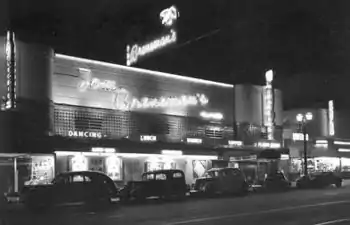Breakfast in Hollywood
Breakfast in Hollywood is a morning radio show created and hosted by Tom Breneman broadcast from 1941 to 1948 on three different radio networks: NBC, ABC and Mutual. These unscripted shows were spontaneous and involved much audience participation. Breneman's many guests included such stars as Jimmy Durante, Andy Devine and Orson Welles.

Radio personality Breneman was in Hollywood having lunch in 1940 with friends at Sardi's Restaurant on Hollywood Boulevard when he realized the location's potential for a radio program. He quickly found an audience when he began broadcasting his Breakfast on the Boulevard January 13, 1941, on KFWB Los Angeles. Newspaper radio schedules indicate that West Coast stations were broadcasting the program as "Breakfast at Sardi's" as early as September 1941.[1] The program was limited to radio stations in California, Oregon, and Washington State until Breakfast at Sardi's aired on the Blue Network from August 3, 1942. One source claims that on February 26, 1943 the title was changed to avoid confusion with Sardi's in New York.[2]
However, newspaper radio schedules for the New York listening area began changing from "Breakfast at Sardi's" to "Breakfast in Hollywood" only in early 1945 while other newspapers referred to Breneman's program as "Breakfast at Sardi's" until mid-1945. The program had numerous sponsors, including Kellogg's cereals, Ivory Flakes, Planters Peanuts, Aunt Jemima Flour, Minute Man Soups and Alpine Coffee. By the mid-1940s, Breneman had ten million listeners. The popularity of the radio program was such that he created his own magazine, and in 1945 he opened his own establishment, Tom Breneman's Restaurant, located on Vine Street off Sunset Boulevard.[3] Organist Korla Pandit was only one of the musical talents who performed at the restaurant.
Film
In 1945, flush with success, Breneman promoted the production of a 90-minute feature film, Breakfast in Hollywood (1946) starring Breneman, Bonita Granville, Beulah Bondi, Raymond Walburn, ZaSu Pitts, Billie Burke and Hedda Hopper, featuring musical numbers by Spike Jones, the Nat King Cole Trio and Andy Russell. Songs include "It Is Better to Be Yourself" by Nat King Cole and "If I Had a Wishing Ring" by Marla Shelton and Louis Alter. "Magic is the Moonlight," "Amor", and "If I had a Wishing Ring" are sung by crooner Andy Russell. The film is available on DVD from Mill Creek Entertainment in the Classic Musicals 50 movie pack.
Other
At the age of 47, Breneman died April 28, 1948, in Encino, California, and other hosts, including Garry Moore, stepped in as replacements, but without Breneman, the ratings dropped, and the program came to an end in January 1949.[2]
Show Format
Intro from MC Johnny Masterson. Hearty " Good Morning Ladies" from Tom. Ivory flakes portion of show starts with visiting patrons: " Who are you?" Ivory flakes commercial. "Going for a hat". Drawing for the wishing ring. 2nd half of show-Kellogs' Pep. Good Good neighbor letter. Uncle Corny joke and confirming he will send out orchid. Pep commercial. Taking bids for oldest lady in attendance. Lovely Armroy orchid & kiss to oldest patron. Signoff with Tom leading the ladies in song. Typical daily audience size was 400-500 people, who started lining up at 5am. Tickets to the broadcast had to be secured in advance.
Tom was also honorary mayor of Encino, CA.
References
- "Radio Programs". Statesman Journal. Salem, Oregon. 28 September 1941.
- Dunning, John (1998). On the Air: The Encyclopedia of Old-Time Radio (Revised ed.). New York, NY: Oxford University Press. pp. 112-113. ISBN 978-0-19-507678-3. Retrieved 2019-02-05.
Breakfast At Sardi's, audience show.
- Tom Breneman's "Breakfast in Hollywood" - Dear Old Hollywood "Breneman originally hosted Breakfast in Hollywood from the former Tropics nightclub on Vine but later bought the Hollywood Recreation Center next door, converting the bowling alley into a restaurant and radio studio."
See also
Watch
- Breakfast in Hollywood is available for free download at the Internet Archive